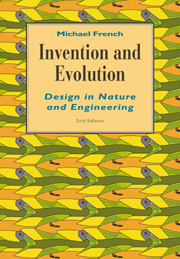Book contents
- Frontmatter
- Contents
- Preface to the second edition
- Preface to the first edition
- Acknowledgements
- 1 The designed world
- 2 Energy
- 3 Materials
- 4 Mechanism
- 5 Structures
- 6 Systems
- 7 The practice, principles and philosophy of design
- 8 Economy, form and beauty
- 9 Production, reproduction, evolution and design
- 10 Designing and inventing
- 11 Some case studies
- Questions
- Answers
- Suggestions for further reading
- Index
8 - Economy, form and beauty
Published online by Cambridge University Press: 06 January 2010
- Frontmatter
- Contents
- Preface to the second edition
- Preface to the first edition
- Acknowledgements
- 1 The designed world
- 2 Energy
- 3 Materials
- 4 Mechanism
- 5 Structures
- 6 Systems
- 7 The practice, principles and philosophy of design
- 8 Economy, form and beauty
- 9 Production, reproduction, evolution and design
- 10 Designing and inventing
- 11 Some case studies
- Questions
- Answers
- Suggestions for further reading
- Index
Summary
Economy, form and beauty
The forms of living organisms have evolved purely to perform vital functions economically. Most of our ideas of visual beauty derive from these strictly functional organisms, trees, flowers, animals, birds and the human body. The natural forms we have come to regard as beautiful are simply very effective and practical designs.
Consider the human arm. We have seen that any limb should have its mass concentrated towards the end attached to the body, so that the inertia to be overcome in movement is kept down: this is particularly important in fast-running animals, where the foot becomes little more than a minimal bony strut and is relatively long, but it is still a consideration in an arm. We have seen how both the minimisation of inertia and the maximisation of reach, or the volume of space which can be swept by the hand or foot, make it desirable to put a three-degree-of-freedom joint at the shoulder and a one-degree-of-freedom joint at the elbow. It is also possible to produce strong, but not rigorous, arguments for three principal joints (shoulder, elbow and wrist) dividing the arm into three segments of which the first two (upper arm and forearm) are roughly equal in length and the third, the hand, much shorter. It is fairly clear, too, that when standing relaxed with the arms hanging loosely the palm of the hand should be towards the body, rather than facing in any other direction.
- Type
- Chapter
- Information
- Invention and EvolutionDesign in Nature and Engineering, pp. 222 - 252Publisher: Cambridge University PressPrint publication year: 1994



